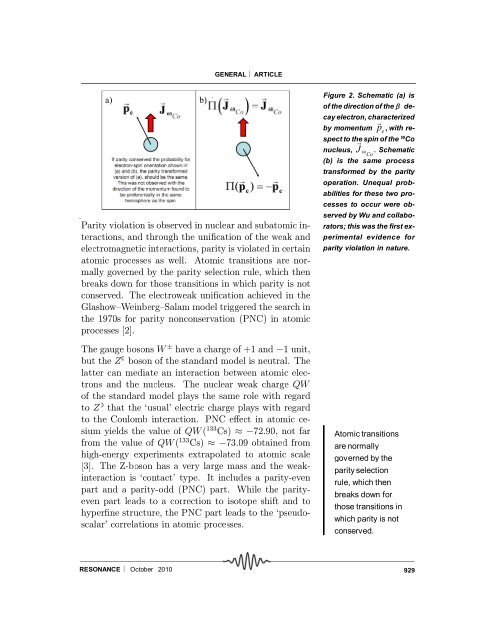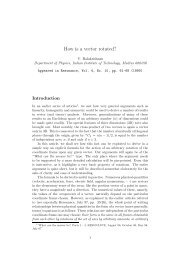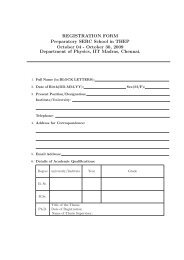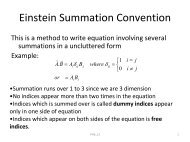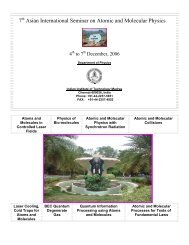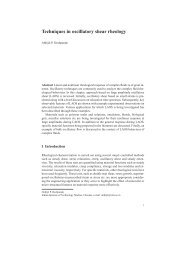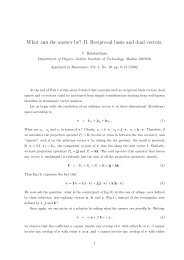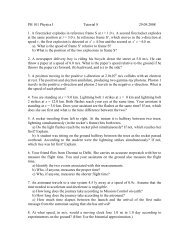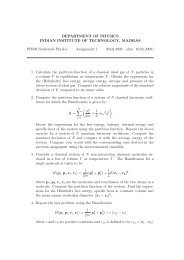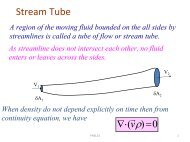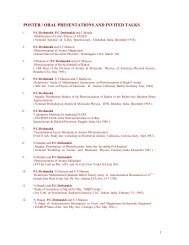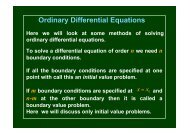Symmetry Principles and Conservation Laws in Atomic and ...
Symmetry Principles and Conservation Laws in Atomic and ...
Symmetry Principles and Conservation Laws in Atomic and ...
Create successful ePaper yourself
Turn your PDF publications into a flip-book with our unique Google optimized e-Paper software.
GENERAL ARTICLEa) b)Parity violation is observed <strong>in</strong> nuclear <strong>and</strong> subatomic <strong>in</strong>teractions,<strong>and</strong> through the uni¯cation of the weak <strong>and</strong>electromagnetic <strong>in</strong>teractions, parity is violated <strong>in</strong> certa<strong>in</strong>atomic processes as well. <strong>Atomic</strong> transitions are normallygoverned by the parity selection rule, which thenbreaks down for those transitions <strong>in</strong> which parity is notconserved. The electroweak uni¯cation achieved <strong>in</strong> theGlashow{We<strong>in</strong>berg{Salam model triggered the search <strong>in</strong>the 1970s for parity nonconservation (PNC) <strong>in</strong> atomicprocesses [2].The gauge bosons W § have a charge of +1 <strong>and</strong> ¡1 unit,but the Z 0 boson of the st<strong>and</strong>ard model is neutral. Thelatter can mediate an <strong>in</strong>teraction between atomic electrons<strong>and</strong> the nucleus. The nuclear weak charge QWof the st<strong>and</strong>ard model plays the same role with regardto Z 0 that the `usual' electric charge plays with regardto the Coulomb <strong>in</strong>teraction. PNC e®ect <strong>in</strong> atomic cesiumyields the value of QW ( 133 Cs) ¼ ¡72:90, not farfrom the value of QW ( 133 Cs) ¼ ¡73:09 obta<strong>in</strong>ed fromhigh-energy experiments extrapolated to atomic scale[3]. The Z-boson has a very large mass <strong>and</strong> the weak<strong>in</strong>teractionis `contact' type. It <strong>in</strong>cludes a parity-evenpart <strong>and</strong> a parity-odd (PNC) part. While the parityevenpart leads to a correction to isotope shift <strong>and</strong> tohyper¯ne structure, the PNC part leads to the `pseudoscalar'correlations <strong>in</strong> atomic processes.Figure 2. Schematic (a) isof the direction of the decayelectron, characterizedby momentum p e,with respectto the sp<strong>in</strong> of the 60 Conucleus, J . Schematic60 Co(b) is the same processtransformed by the parityoperation. Unequal probabilitiesfor these two processesto occur were observedby Wu <strong>and</strong> collaborators;this was the first experimentalevidence forparity violation <strong>in</strong> nature.<strong>Atomic</strong> transitionsare normallygoverned by theparity selectionrule, which thenbreaks down forthose transitions <strong>in</strong>which parity is notconserved.RESONANCE October 2010929


